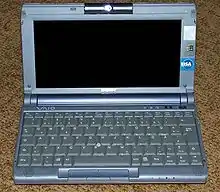Subnotebook
A subnotebook (also called an ultraportable, superportable or mini notebook) is a class of laptop (or 'notebook') computers that are smaller and lighter than a typical notebook.
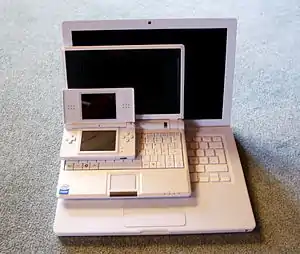
These computers are sometimes confused with the ultra-mobile PC category, which is the name of a platform of small form-factor tablet PCs. UMPCs are smaller than subnotebooks, however both generally run full desktop operating systems such as Windows or Linux, rather than specialized software such as Windows CE, Palm OS, or Internet Tablet OS. Subnotebooks are also sometimes confused with netbooks which are a different category of devices that branched off from mini notebooks in general. Netbooks are most often much less expensive than subnotebooks, as they are optimized for use as portable Internet capable devices and generally lack the processing power of a workstation. Netbooks typically have 9W TDP CPUs, sacrificing performance for power efficiency, whereas subnotebooks often use 18W TDP processors.
Subnotebooks are smaller than full sized laptops but larger than handheld computers. They often have smaller-sized screens, less than 14 inches, and weigh less than typical laptops, usually being less than 2 kg (4.4 lbs). The savings in size and weight are usually achieved partly by omitting ports and optical disc drives. Many can be paired with docking stations to compensate.
History
Before 1990
The Compaq LTE, launched in 1989, was the first to be widely known as a "notebook computer" because its relatively small dimensions — 4.8×22×28 cm (1.9 × 8.5 × 11 inches) — matched those of a pair of stacked US Letter (similar to A4) size paper notebooks. The Compaq was followed by IBM PS/2 note and PS/55note lines in 1990, then, in October 1992 by the very popular IBM ThinkPad, which was the first to include a 10.4" diagonal (8.3" x 6.2" outline) screen in a notebook measuring 5.6 × 21.1 × 28.4 cm (2.2 × 8.3 × 11.7 inches). Portables with noticeably smaller form factors thus became known as subnotebooks. The term was also applied to the NEC UltraLite, unveiled in 1988 — although its dimensions (1.4" × 8.3" × 11.75") were very similar to the Compaq LTE, but NEC measuring a significant less weight (typically 4.4 lb (2.0 kg)).[1]
Smaller DOS-based PCs such as the Poqet PC and the Atari Portfolio—both released in 1989—were called either "pocket PCs" or handhelds.
1991–1995
The early relatively compact notebooks was the PowerBook 100 released in 1991 by Apple, still bulky and heavy machine that measuring 1.8 × 8.5 × 11 inches and weighing 5.1 lb (2.3 kg),[2] and HP 95LX[3] — compact handheld PC with limited functionality, but only 0.3 kg weight, from other hand. In the end of 1992 the PCMag magazine[4] branded two actual models as subnotebooks: this was a Gateway Handbook, originally released in 1992 and updated to use a 486 processor in late 1993 (these model was only 1.6 × 5.9 × 9.7 inches (41 × 150 × 246 mm) and weighed less than three pounds (1.4 kg)) and Dell 320SLi laptop with 3.6 lb (1.6 kg) weight.[5][6] Another true subnotebook then was released in the same year: the Olivetti Quaderno[7] has been produced in Italy, had a compact 32 x 148 × 210 mm case and was only 1.05 kg weight.[8] At the same time the more regular laptop lines reduced their dimensions, for example, the Apple new PowerBook Duo series, which further reduced their notebook line to 1.4 × 8.5 × 10.9 inches (with 4.1 lb (1.9 kg) weight), and Compaq upgraded LTE series with Lite model with 1.8 x 8.5 x 11 in size[9] (this model still weight 6 lb (2.7 kg), but had a color screen); and both lines supporting few on-board features, but which could be inserted into a docking station to achieve the full functionality of a desktop – a succession feature of IBM PS/2 note docking station predecessor (IBM Communications Cartridge)[10][11] and soon emulated by other manufacturers.
Another early subnotebook was the Hewlett-Packard OmniBook 300, which was launched as a "superportable" in 1993. It measured 1.4 × 6.4 × 11.1 inches, weighed 2.9 lb (1.3 kg) and was available with an optional Flash memory disk instead of a hard drive, to reduce the weight.[12]
Toshiba, which had concentrated on portables in the 1980s, also entered the market that year with the Portege T3400, claiming that "It's the first subnotebook computer with all the functionality of a much larger computer".[13] The version with an 8.4″ monochrome screen measured just 1.7 × 7.9 × 9.8 inches and weighed 1.8 kg. Toshiba also introduced the T3400CT at this time which was the first subnotebook with a color screen.
Then Toshiba really put the subnotebook PC format on the map in 1995 with the Libretto 20. This featured a 6.1″ screen and 270 MB hard disk. CNet reported about the Libretto 50CT that "[it] is the first full-fledged Windows 95 notebook in the United States weighing less than two pounds".[14]
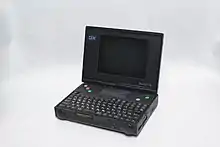
IBM released a Palm Top PC (handheld laptop with 4.7" screen) in 1995.[15]
Compaq introduced its own short lived subnotebook line in 1994 called Contura Aero, which had two models: the greyscale display 4/25 and the color 4/33, notable for using a battery which was intended to be standard rather than only useful for Compaq products.[16]
1996–2000
IBM had sold "thin and light" models in its ThinkPad range, such as the ThinkPad 560 ultraportable (1996) and best-selling ThinkPad 600 (1998). It finally entered the subnotebook market in 1999 with the 1.3 kg ThinkPad 240, targeted at business travellers.[17] The 240 and 240X had 10.4″ screens. Later, however, IBM replaced these with the X range, with 12.1″ screens. At 8.3″ × 10.6″, the ThinkPad X40 is not much smaller than A4 (8.3″ by 11.7″) and better described as an ultraportable, rather than a subnotebook. But more compact and affordable IBM WorkPad z50 (thin client with 8.2" screen, released in 1999) don't get a market success.[18]
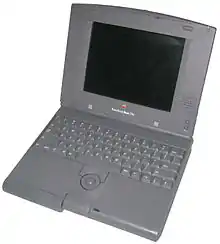
In 1997, Apple replace the aging PowerBook Duo line with relatively light-weight (4.4 lb (2.0 kg)) but short-lived PowerBook 2400c; this was co-designed by IBM and made for Apple by IBM Japan. However, it measured 1.9 × 8.5 × 10.5 inches (48 × 220 × 270 mm), so it was actually bigger than a Compaq LTE notebook.
In 1997 Mitsubishi Electric released ultra-compact ultrathin Mitsubishi Pedion 12.1" laptop line with magnesium case (18 × 218 × 297 mm) and chiclet keyboard.[19] This short-living model line was sold only in Japan and discontinued after some hardware issues.
Sony launched an ultraportable (ultrathin) less than an inch thick in Japan in 1997, the PCG-505, which reached the US in 1997 as the VAIO 505GX. This was followed by the even thinner Sony VAIO X505, which measured just 0.8 × 8.2 × 10.2 inches, and reached 0.3″ at its thinnest.[20] However, it was very expensive and had poor battery life, and was soon withdrawn.
Sony also launched the C1 range of subnotebooks, starting in Japan in 1998.[21]
2001–2006
One of the most notable Sony models was the Transmeta-based Vaio PCG-C1VE or PictureBook (2001), which measured only 1×6×9.8 inches. It had a digital camera built into the lid, which could be used for video conferencing or swivelled round to photograph a scene.[22]
This was followed in 2005 by the Transmeta-based Flybook convertible with a touch-sensitive 8.9 inch. widescreen from Taiwan's Dialogue Technology. (Later models used Intel ULV processors.) The Flybook features a built-in phone connection for GPRS or 3G networking, and is available in a range of bright colors. This attracted the attention of non-computer magazines including GQ, FHM, Elle and Rolling Stone.[23] Dimensions of 9.3″ × 6.1″ put the original Flybook A33i on a par with the Libretto,[24] but styled to appeal more to fashion models than computer geeks.
In 2006, Microsoft stimulated a new round of subnotebook development with the UMPC or ultra-mobile PC format code-named Origami. These are basically small versions of Tablet PC computers, which originally shipped with the Microsoft Windows XP Tablet PC Edition 2005. An example is the Samsung Q1.
2007–present
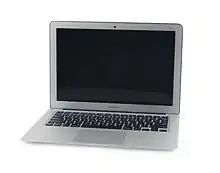
In 2007 the ASUS Eee PC became the first of a new class of low-cost subnotebook commonly called the netbook. These devices are based around using the Internet. Netbooks are typically based upon the Atom processors, while other subnotebooks use more powerful processors such as ULV types.
In 2008, Apple introduced the MacBook Air, which the company claimed was the world's thinnest notebook. The MacBook Air offers a 13.3" widescreen, LED backlit display that's instant-on. It also includes a built-in iSight camera, a full-sized, backlit keyboard and a "trackpad"-branded touchpad with support for multi-touch gestures. However, the MacBook Air offers no built-in optical drive.[25] The latest iteration of the MacBook Air weighs 2.96 pounds (1.35 kg).[26]
At Computex 2011 Intel announced a new class of subnotebooks called Ultrabooks. The term characterises a highly portable laptop that has strict limits on size, weight and battery life and has tablet-like features such as instant-on functionality.
In 2015 LG introduced what is probably the lightest 14" laptop, weighing 0.98 kilograms (2.2 lb), less than an 11.6" MacBook Air.[27]
See also
| Wikimedia Commons has media related to Subnotebooks. |
- List of computer size categories
- Netbook
- Palmtop
- Intel Mobile Internet Device
- UMPC, a small form-factor tablet PC platform
- Smartbook
- Pandora (console), a cross between a handheld game console and a subnotebook
References
- "Archive ULTRALITE-LIST: file specs.txt, part 1/1, size 4055 bytes".
- "Macintosh PowerBook 100: Technical Specifications". support.apple.com. Retrieved 6 April 2018.
- "Retro Isle - HP95LX, 100LX and 200LX". retroisle.com. Retrieved 2021-01-06.
- Inc, Ziff Davis (1992-10-27). PC Mag. Ziff Davis, Inc.
- Torgan, Emerson (1992-10-13). Dell Breaks the Full-Featured 4-Pound Barrier with Compact 320SLi. PC Mag. p. 46.
- Lee, Yvonne (1992-06-08). Dell's notebook drops the weight, retains the power. InfoWorld. p. 18.
- "Lavorare dovunque: i computer portatili Olivetti". Archived from the original on 2 April 2015. Retrieved 2 April 2011.
- "Olivetti QUADERNO(PT-XT-20) 1992年". 古いハードに囲まれて. Retrieved 2020-12-05.
- "LTE Lite 4/25C | 102711563 | Computer History Museum". www.computerhistory.org. Retrieved 2021-01-06.
- "IBM Communications Cartridge" (PDF).
- http://ps-2.kev009.com/basil.holloway/boo-to-pdf/S10G_4421_00.pdf
- Hardware Archived 2012-02-27 at the Wayback Machine
- "Support – Business PCs - Toshiba". www.toshiba-europe.com. Retrieved 6 April 2018.
- "Toshiba unwraps subnotebook". cnet.com. 2 June 1997.
- 1995 Press Release - 年のプレスリリース一 IBM.com
- "QuickSpecs -- Compaq Contura Aero (Consumer Products)". www.rigacci.org. Retrieved 2021-01-06.
- "FindArticles.com - CBSi". findarticles.com. Retrieved 6 April 2018.
- HPC:Factor. "IBM Workpad z50 Review". HPC:Factor. Retrieved 2020-12-04.
- "Pedionペディオン (Mitsubishi) 1997年". 古いハードに囲まれて. Retrieved 2020-12-05.
- "Sony VAIO X505 review: Sony VAIO X505". 31 August 2004. Retrieved 6 April 2018.
- "Sony Global - Press Release - Sony Announces New VAIO Notebook Computer Equipped with a Built-in Miniature CCD Video Camera for Sending Images over E-mail". www.sony.net.
- "Archived copy". Archived from the original on 2002-06-03. Retrieved 2007-02-16.CS1 maint: archived copy as title (link)
- "Fly book - The world's most popular frequent flyer community - Fly book is a living, growing community where frequent travelers around the world come to exchange knowledge and experiences about everything miles and points related". www.flybook.biz. Archived from the original on 22 November 2005. Retrieved 6 April 2018.
- "ARN - The voice of the Australian IT channel". ARN. Archived from the original on 2008-11-20. Retrieved 6 April 2018.
- "It was the MacBook Air sub-notebook". Retrieved 2017-12-27.
- "MacBook Air (13-inch, 2017) - Technical Specifications". support.apple.com. Retrieved 2017-12-27.
- "LG's newest 14' laptop weighs less than Apple's 11' MacBook Air". TechRadar. Retrieved 2017-12-27.
